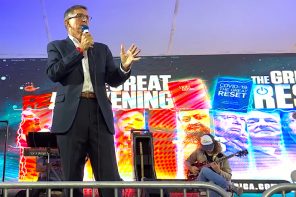I once made the grievous error of spending ten minutes of my life watching the opening scenes of Transformers: Dark of the Moon. I was intrigued that it was listed in my Netflix queue as a “conspiracy” film. And though I abandoned it quickly, I was struck then by a shift in the conspiracy idiom since the 1970s, one that I have been thinking about of late.
We can see in older films like Three Days of the Condor a suspicion and a paranoia which seem superficially consistent with the present; but in these early, post-Watergate films there was an idealist’s sense of betrayal that always pointed to the desire for transparency and restitution—a conviction that the world may be darker and graver now but that the possibility of right still existed (provided that the protagonist lived long enough).
Now, as I have written elsewhere, the conspiracy and the apocalyptic idioms are so ubiquitous—those black-suited agents of the Leviathan state, those flashy secret technologies, that endless night pregnant with threat and meaning—they have made the conspiratorial almost an aesthetic.
As I wring my hands along with the rest of the world, anxious about what has happened in Syria and about what might happen still, I perceive that one of the many discourses swirling around this focus is what I’d call a permanent religious apocalyptic. While it would be wrong to attribute this way of reading to the conspiratorial proper, it shares with anti-political pop a tone, a context, and a meaning made through a kind of abandonment of a shared world.
I leave it to other pieces to pronounce that war is wrong, since I take it as axiomatic that most people reading this are, as Secretary of State John Kerry said Friday, “tired of war.” I write instead about the impulse to search for and locate “religion” in events like these, and to think about how we think about “evidence” in so doing.
Much has been said in response to the Syrian civil war and the recent use of chemical weapons. Former Defense Secretary Donald Rumsfeld, of all people, cautioned that there is insufficient evidence to justify military intervention. The Obama administration (Kerry specifically) countered that there was such evidence, though was notably reticent about actually presenting it. And British Prime Minister David Cameron insisted similarly that the circumstance passed the “legal test” for just humanitarian/military intervention.
But of course our world is made of the overgrowth of words and opinions that spasm exponentially in response to such pronouncements, and even horror becomes yet another occasion or opportunity for establishing causality and connections, for mapping the amorphous: some allege that the seemingly inevitable military strike will be a proxy war between America and Iran, some see in it only another boondoggle the U.S. would be wise to avoid (Red State recently hollered that the only sensible course was in “Letting Allah Sort Out Islamic Civil War”), while still others see in it the long backlash of Cold War odd bedfellows.
Violence as “Evidence” of Redemption
But the common experience is in the existence of a really real that official discourse is obscuring, and that the intrepid blogger or diligent exegete can tell us what’s really going on. And so the endless apocalyptic rears up once again, on self-recorded Youtube uploads, on niche cable programming, in a hyperlinked world of insistence: Damascus is, we are reminded, geographically central to the projected Second Coming of Christ.
This mode of reading sacred texts onto geopolitical conflicts in the Middle East is, of course, extremely commonplace (a long tradition dating back to the Crusades, spiking with the publication of the Scofield Reference Bible, and becoming enormously popular with Hal Lindsey). The text most commonly cited here is Isaiah 17:1:
“Behold, Damascus will cease to be a city and will become a heap of ruins.”
Apocalyptic scenes (additionally from Jeremiah and Zechariah) extend to Damascus, and the Qur’an, too, locates Christ’s eventual return just east of Damascus. As other observers have noted, the city itself fares differently in each vision: its physical condition, the sequence of its destruction, the particular plot in which it figures. But the co-resonance of violence and religious teleology is unavoidable from a certain perspective, one conditioned to gather together the fragmentary world in a meaning where violence is no counter-sign to redemption but evidence of its certainty.
This must be the time and place of the Second Coming, it is avowed, because we see before us ruinous scenes that seem to capture our own sense of the world’s brokenness. The endless violence and precarity we lap up in entertainments and bemoan on streets is here underscored with a different valence of meaning, a clear direction. It tells us that this time is simultaneously not the real time, the meaningful time, but is nonetheless crucially on the brink of conversion into realness and importance. This is indexed not only on the pages of scripture but in our feelings themselves, now understood as an alternate reservoir of evidence or “proof.”
The coexistence of this evidentiary mode of “religion” with those of other bodies of/in evidence seems to me to signal other means by which “religion” takes shape in the public imagination, and by which it both performs and flouts convention. Religion and the state co-emerge in discourses about American responsibility and Syrian chaos, together standing for the violence of ontological breakings into and breakings down of the “communal World” as it appears to custom, and figuring equally in the restoration or defense of such worlds.
So “religious enthusiasm” or the American apocalyptic can be read as modes of the disaffection of the citizen in a time of political delegitimation. We often see this “religion” taking shape most clearly when we focus all the way down, to the odd hybrid of melancholy and triumphalism in these assertions about Damascus.
The ephemeral links between scripture and the present are made firm through the intensity of feeling, of insistence, of horror in the face of the really real—which is not only gassed children but, to the American dispensationalist, a wayward Obama administration.
If such intense religious feelings act as, in Brian Massumi’s words, “the invisible glue that holds the world together,” perhaps the shock and uncertainty of Syria (and its shocked but certain responses) direct our attention to the role of temporal urgency in religion’s capacity to span subjects, events, and locations, constructing from them a relation and a resemblance—whether this is adduced to the “political,” the “religious,” or something else.
The present’s urgency makes the future into the now, which can be understood as—citing Proust—“giving rise to what is ‘real without being actual, ideal without being abstract.’”
Tweeting the Real
We live in a time of lies, and endlessly deepening, circulating suspicion. This is also a time of exhaustion, powerlessness, anomie, and drift. The performance and demonstration of “truth” is thus everywhere assailed, but we still demand that it remain a central category (if not for politics as such, then for our affective experience of the political). This partly explains the zeal for evidence, for observability and substance. But when “religion” enters the swirling tide of words and allegations, it complicates things.
On the one hand, “religion” has played a role in two hidebound discourses: we must use it to steer the ship of state towards morally desirable ends, or we must keep it out of politics altogether so that decisions can be made reasonably (there are subsets of these umbrella claims, having to do with the size of bureaucracy, the content of “public speech,” or exemptions to the rule of law). But we see here a “religion” that turns away from political order altogether, which—while this, too, has an extremely lengthy history—resonates with peculiar intensity in the age of virality, Wiki-truth, and the triumph of feeling.
In these furiously retweeted exegeses about Damascus, “religion” is announces a different order of valuation, not so much abandoning the possibility or legitimacy of military action, or relinquishing altogether any claims to membership in society, so much as grounding any of these conversations in a different raft of evidence: texts and feelings working together to produce the real, the authentic so evidently lacking elsewhere.
These varied forms of “evidence” and interpretation polarize citizens, since they make of shared tropes and texts and histories forms of difference that are posited as natural. “Religion” demands of us, in its very ephemerality, the kind of insistence and certitude that characterizes our shrill politics today. So this presentation of varieties of evidence is both symptom and substance of a shared condition. It is not only a vector by which “religion” enters public discourse, but a crucial means by which we identify and measure the merits of “religion”: a corrosive fundament, a wince-inducing distraction, a necessary corrective.
At the very least, these stock formats for evidence gather up particulars—even the raw experience of suffering and misery so clearly at work now—and make of them details in the service of a not-yet, a “real story” that may come in military action or redemptive return. In each case, though, when it seems that the very possibility of coherence or reasoned discourse is blasted away by the fractious multiplicity of our politics, religions help lend to this constant vertiginous now the structure of a narrative—or better yet, an action movie that livens up our drab lives dulled by the grind of neoliberalism.
While we all dwell anxiously before the thought of what might be, it is this sobering notion I keep returning to. In their emotional resonance and sometimes exclusive certitudes, it may be that religions furnish in citizens forms of emotional experience or languages that change the experience, the medium of the political. If so, the Youtube uploads and blog posts about Damascus’ many meanings are not just indices of otherness or shared technologies.
What is more relevant than the endless clashing of opinions about such fearful events is how the introduction of “religion” into politics gives us all a way of naming and also avoiding our shared condition: one where the experience of simply being overwhelmed coexists with a fantastic apathy, leaving a state where outrage and proclamations of the end mask our inability to shape a shapeless world.
This affords neither the whiff of conspiracy nor the satisfactions of narrative, but if there is a real story perhaps this is it. And what is more, we have all seen (and been in) this movie before.




